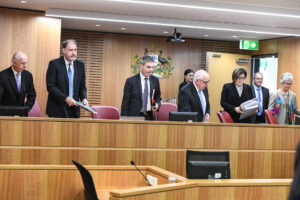Don’t Pop Champagne Corks Over Longest Growth Streak
Share
On April 1, Australia will surpass the Netherland’s old record to mark the longest unbroken expansion of real GDP in modern history. While this result permits much chest-thumping on the part of some politicians, we should never assume that there is an automatic correlation between GDP growth and the well-being of people, society, and the environment.
In this guest commentary, Prof. Anis Chowdhury – a new Associate of the Centre for Future Work, and a distinguished global economist – provides some important perspective on this longest expansion in history.
Little to Rejoice About in Australia’s Record-Long Expansion
by Anis Chowdhury
On April 1, Australia will overtake the Netherlands to lay claim to the title of the longest economic expansion on record, entering our 104th quarter of economic growth, as the nation narrowly avoided slipping into a technical recession.
With the release of the GDP figure on 1 March, the government expressed a sigh of relief. It showed that Australia’s economy grew by 1.1 per cent in the last quarter, after slipping 0.5 per cent in the three months to December 1.
Should we rejoice at this?
It seems, Treasurer Scott Morrison thinks so. As the government is breathing easy, the Treasurer responded by saying “Our growth continues to be above the OECD average and confirms the successful change that is taking place in our economy as we move from the largest resources investment boom in our history to broader-based growth.”
To be fair, the Treasurer was also cautious and acknowledged that nation’s economic growth “cannot be taken for granted and is not being experienced by all Australians in all parts of the country in the same way”.
However, with this cautionary note the Treasurer has contradicted himself. If the nation’s growth cannot be guaranteed; if all Australians in all parts of the country are not sharing the benefit of this longest stint of growth, then it is simply not broad-based; nor is it inclusive.
The nation’s growth still comes largely from mining, agriculture, forestry and fishing, as its manufacturing sector continues to shrink. The share of manufacturing in GDP now stands at around 6 per cent which is less than half what was four decades ago. Despite the longest growth stint, Australia still remains a primary-producing, two-speed economy.
Australia’s terms of trade — the ratio of the nation’s export prices to its import prices — grew by 9.1 per cent, thanks to strong price rises in coal and iron ore, marking a 15.6 per cent improvement on the December 2015 quarter.
Thus, Australia’s economic growth continues to be driven by commodity price booms, behind which is the economic expansion in emerging Asian economies, mainly China and India. If these economies sneeze, Australia will catch a cold. Hence, the Treasurer is correct, the “nation’s growth cannot be guaranteed”; it cannot be sustained.
Even if it is sustained, it is not sustainable in the sense of ensuring social stability and protecting the environment. Australia’s current development trajectory is unlikely to achieve the Agenda 2030, the most ambitious and transformative goals for sustainable development adopted by the nations of the world in September 2015 at the United Nations.
Let us reflect on some key indicators. First, Australia’s official unemployment rate edges up to 5.9 per cent in February, from 5.7 per cent in January, while underemployment skyrocketed to 1.1 million. The staggering underemployment is more a structural problem than a result of cyclical phenomena. The rise in unemployment and underemployment happened, even when we were told that labour market flexibility would boost employment – the main argument put forward in supporting recent cuts in penalty rates.
Second, even without the penalty rate cuts, wages growth has been stagnant. The 1.1 per cent GDP growth that technically saved the economy from a recession, was accompanied by falling employee compensations by 0.5 per cent.
Thus, the 0.9 per cent increase in household consumption, contributing 0.5 per cent to growth, which according to the Treasurer, was a key factor in bolstering the post-mining boom economy, seems to have been debt-driven. No wonder, Australia’s household debt at close to 125 per cent of GDP, is now the third highest in the world. At 187 per cent of household income, the RBA’s worries about household debts are not unfounded.
Third, the divide between rich and poor is growing in Australia, according to a new national survey, which found more than a quarter of households have experienced a drop in income. At the same time, the socio-economic conditions of indigenous Australians remains shamefully at the Third World level. They don’t live as long as other Australians. Their children are more likely to die as infants. And their health, education and employment outcomes are worse than non-Indigenous people. Despite promising to close this gap on health, education and employment, the 2017 “Closing the Gap” report card finds that we are failing on six out of seven key measures. With less than year until the first wave of “Closing the Gap” deadlines, the road to reducing Indigenous disadvantage appears ever longer.
Fourth, the latest Australia’s Environment Report 2016 reveals that Australia’s biodiversity is under increased threat and has, overall, continued to decline. It also reveals that pressures on the environment has increased from coalmining and the coal-seam gas industry, habitat fragmentation and degradation, invasive species, litter in our coastal and marine environments, and greater traffic volumes in our capital cities.
While the quality of growth and overall socio-economic well-being continue to regress, what is the response from government? Regrettably, it is the same mantra: “repair the budget”; “cut welfare expenditure”; “cut wages and employment conditions”; “cut company tax”; “cut environmental regulation”, etc.
Why these cuts? Because they will help keep our triple A credit rating! In the words of the Treasurer, “We must take the necessary steps to keep expenditure under control structurally, to boost investment, to maintain the AAA credit rating…”
That is a huge leap of faith in the face of contrary findings world-wide, including Australia, that these sorts of measures do not boost investment; they do not fix the structural problems in the economy; they do not close the societal divide (between the rich and the poor, between indigenous peoples and the rest of Australia); and they do not protect our biodiversity or mitigate pressure on our environment.
Public policies for structural transformation and environmentally sound, inclusive growth are for the brave hearts, not for the meek who remain hostage to the unaccountable credit rating agencies.
Between the Lines Newsletter
The biggest stories and the best analysis from the team at the Australia Institute, delivered to your inbox every fortnight.
You might also like
Productivity is often mistaken for wages. What does it really mean? How does it work?
Australia’s productivity growth has reverted to the same stagnant pattern as before the pandemic, according to the Productivity Commission’s latest quarterly report. Productivity is complex and often misunderstood in media and policy debates. So before we read too much into this latest data, here are six key things to understand about productivity. 1. It’s about quantities,
If business groups had their way, workers on the minimum wage would now be $160 a week worse off
Had the Fair Work Commission taken the advice of business groups, Australia lowest paid would now earn $160 less a week.
The continuing irrelevance of minimum wages to future inflation
Minimum and award wages should grow by 5 to 9 per cent this year



